If you’ve ever worn black pants around your Labrador and instantly regretted it, you’re not alone. Labs shed year-round, and during spring and fall, it feels like you’re living with a fur-producing machine.
But here’s the truth: you don’t need to resign yourself to a life of lint rollers and constant vacuuming. These ten proven strategies will help you take control of the shedding situation without spending hours every day on grooming. Let’s transform your home from a fur-covered chaos zone into a manageable, cleaner space.
1. The 10-Minute Weekly Blowout Technique
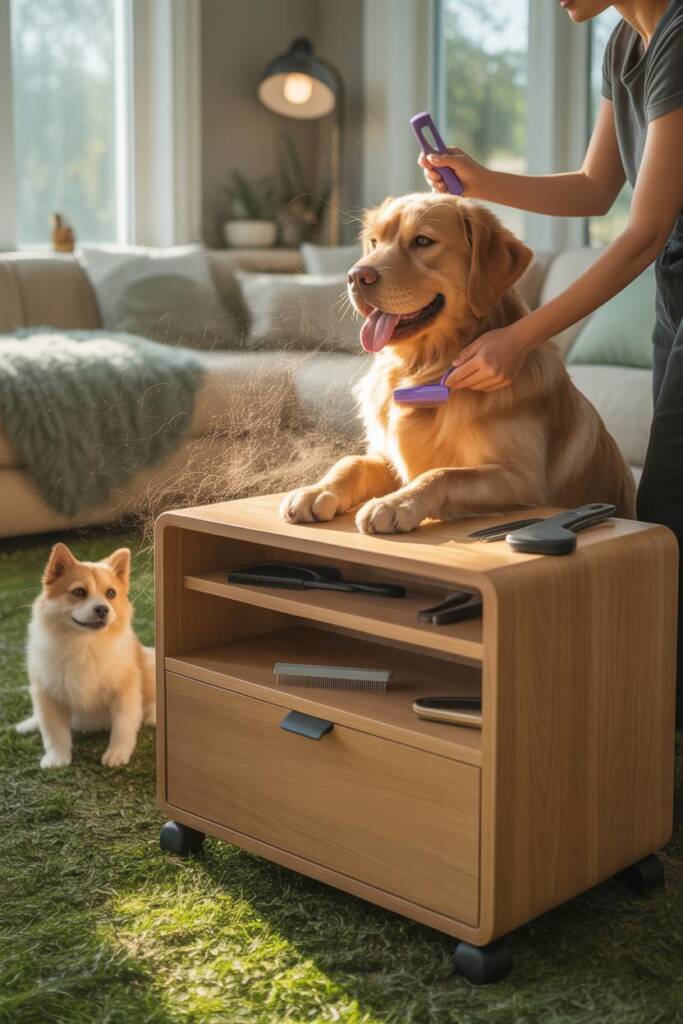
Forget daily light brushing that barely makes a dent. The real secret to controlling Labrador shedding is one intensive 10-minute session per week that removes the undercoat before it ends up on your couch. This concentrated approach works because Labs have a double coat, and that fluffy underlayer is what creates most of your household tumbleweeds.
Why This Works Better Than Daily Brushing
Daily brushing only skims the surface, literally. Your slicker brush catches the loose top coat, but the dense undercoat stays put until it’s ready to shed naturally. A weekly blowout session uses an undercoat rake or de-shedding tool that penetrates deep into that secondary layer, pulling out dead fur in clumps. You’ll be amazed at how much comes out in one focused session compared to seven days of light brushing. Plus, your Lab will love the deep massage-like sensation.
The Exact Tools You Need
Invest in a high-velocity dog dryer and an undercoat rake with rotating teeth. Start by brushing against the grain with the rake for 5 minutes, working in sections from tail to neck. Then switch direction and brush with the grain for another 5 minutes. The rotating teeth prevent pulling and discomfort while maximizing fur removal. Do this outdoors if possible, because you’ll create what looks like a small fur tornado.
2. Add These 3 Ingredients to Every Meal
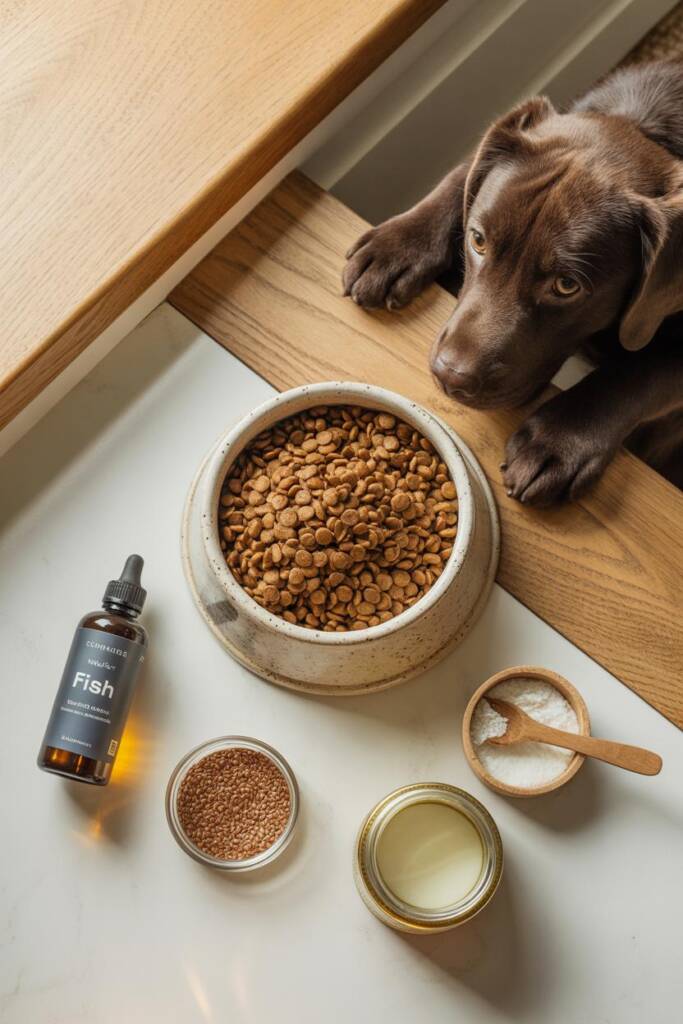
Your Lab’s diet directly impacts skin health, and healthy skin means less excessive shedding. While shedding is natural, nutrition deficiencies can make it worse than it needs to be. Three simple additions to your dog’s regular meals can strengthen hair follicles and reduce the amount of loose fur floating around your home.
The Omega-3 Game Changer
Add a high-quality fish oil supplement (dosed according to your dog’s weight) to one meal daily. Omega-3 fatty acids strengthen the hair shaft and reduce inflammation that can trigger excessive shedding. You’ll also notice your Lab’s coat becomes shinier and feels less dry to the touch. For an even bigger boost, add a tablespoon of ground flaxseed and a teaspoon of coconut oil to their meals three times per week. These work synergistically to support skin barrier function.
When You’ll See Results
Don’t expect overnight miracles. It takes about 6-8 weeks of consistent supplementation to see noticeable changes in coat quality and shedding volume. Mark your calendar and take before photos, because the change is gradual enough that you might not notice day-to-day, but the difference after two months is significant. Many Lab owners report 30-40% less fur accumulation on floors and furniture once the supplements kick in.
3. The Pre-Bath De-Shedding Secret
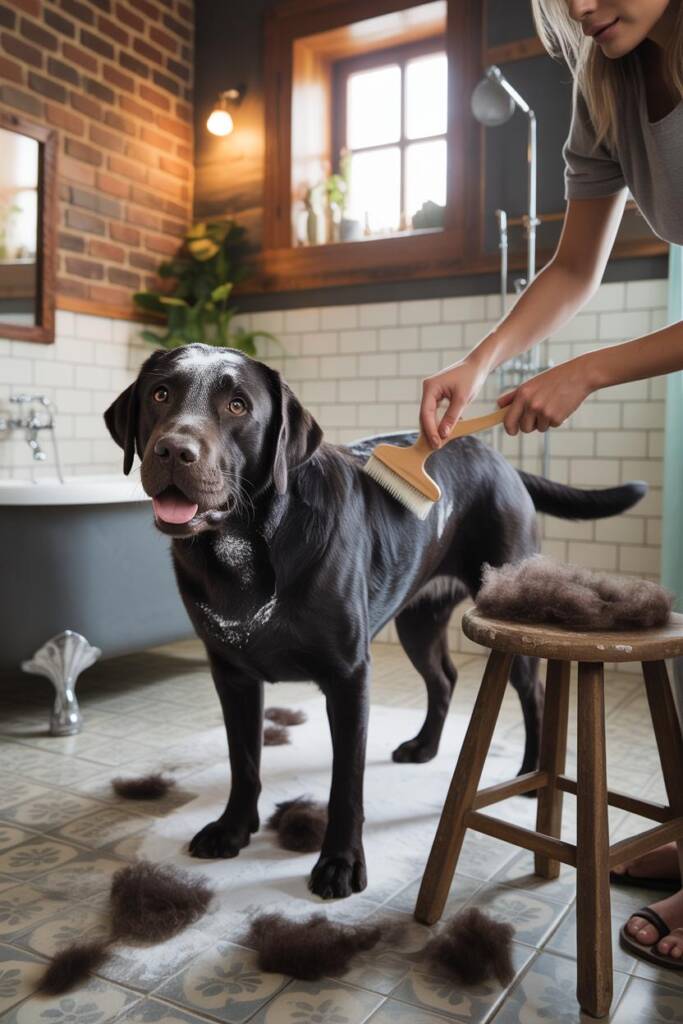
Most people bathe their Lab and then wonder why fur explodes everywhere for the next three days. Here’s what professional groomers know: water loosens dead undercoat, and if you don’t remove it before the bath, it clumps and mats, then falls out in chunks as your dog dries.
The 15-Minute Prep That Changes Everything
Before bath time, sprinkle cornstarch or grooming powder throughout your Lab’s coat, working it down to the skin with your fingers. Let it sit for 5 minutes (the starch absorbs oils and helps fur release from follicles), then brush thoroughly with an undercoat rake for 10 minutes. You’ll pull out massive amounts of loose fur that would otherwise clog your drain or end up scattered through your house. This simple prep step reduces post-bath shedding by at least 60% and makes the actual bathing process cleaner and faster.
4. Strategic Furniture Zoning (Your New Best Friend)
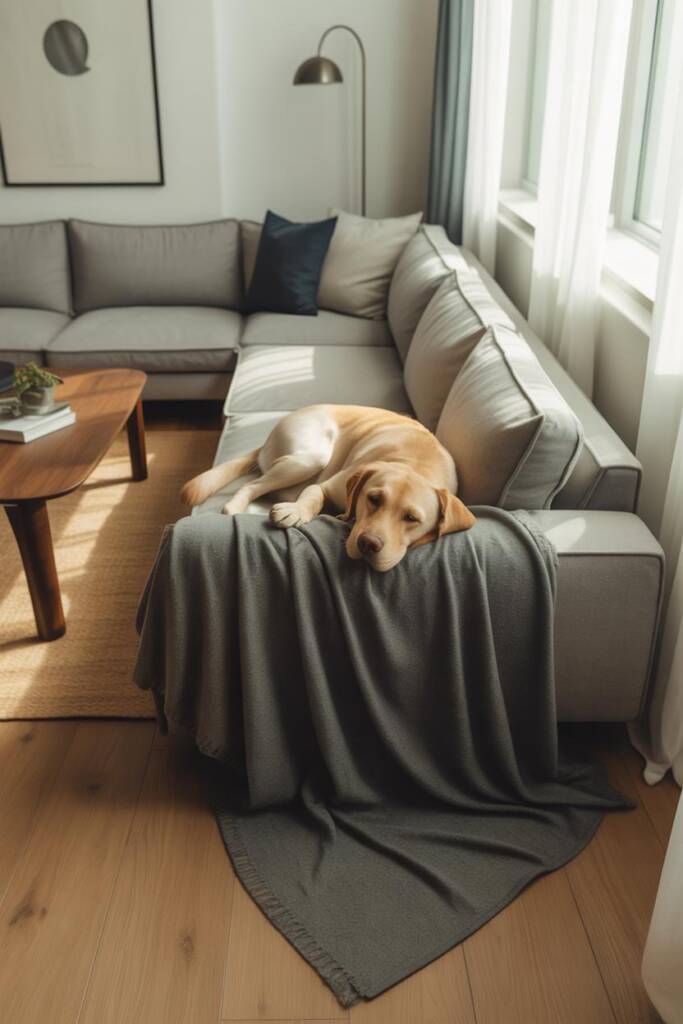
You don’t need to cover every surface in your home with ugly blankets. Instead, identify your Lab’s three favorite lounging spots and protect those strategically with washable, attractive covers.
The 80/20 Rule for Cover Placement
Labs are creatures of habit. They have preferred napping spots, and 80% of the furniture fur accumulates in just 20% of your seating areas. Watch your dog for a week and note where they consistently settle. That’s where your furniture covers go. Choose microfiber or tightly-woven cotton covers in colors that complement your décor, not clash with it.
Stylish Options That Don’t Scream “Dog House”
Skip the quilted floral covers from the pet store. Instead, look for modern waterproof furniture throws in solid neutrals or subtle patterns. Brands designed for kids’ furniture protection often work perfectly for dogs and look more sophisticated. Velvet-texture covers in charcoal, navy, or taupe blend seamlessly with most furniture styles while repelling fur thanks to their tight weave. Wash them weekly on hot with a cup of white vinegar to remove embedded fur and keep them looking fresh.
5. Set Your Robot Vacuum on a Shedding Schedule
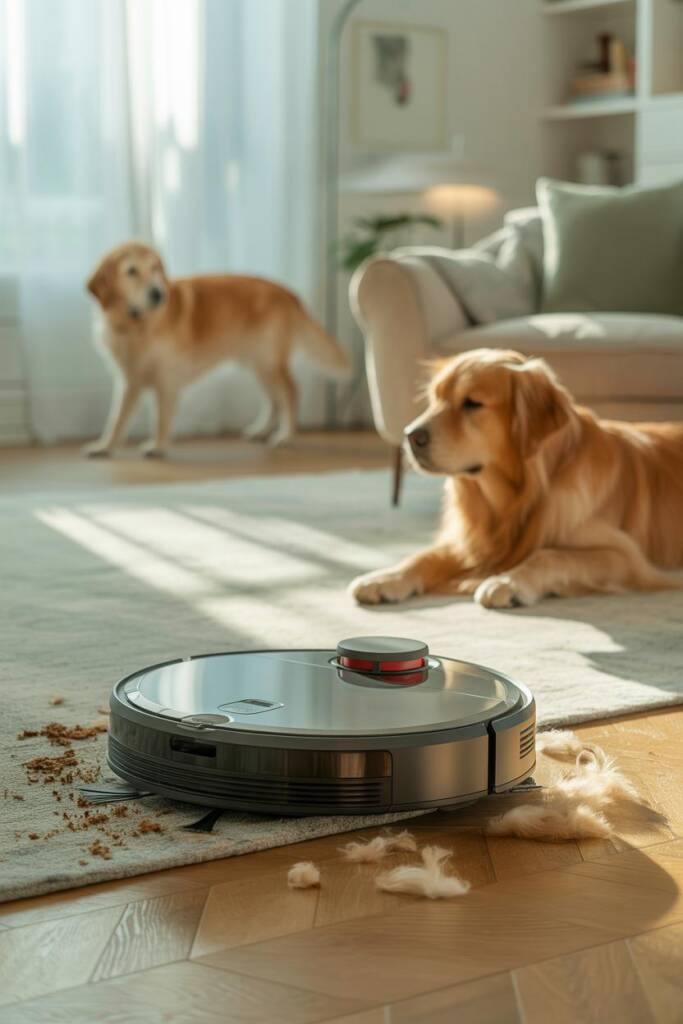
A robot vacuum isn’t a luxury for Lab owners; it’s a sanity-saver. But most people run theirs randomly, which means fur builds up between cleanings. The trick is programming strategic run times that align with your dog’s shedding patterns and your household traffic.
The Best Times to Auto-Run
Schedule your robot vacuum to run twice daily: once mid-morning after your Lab’s first active period (when they’ve moved around and shaken loose fur everywhere), and again in early evening before family members come home. This catches fur at peak shedding moments rather than letting it accumulate into visible tumbleweeds. During spring and fall shedding seasons, add a third midday run if you’re home.
Models That Actually Handle Lab Hair
Not all robot vacuums are created equal when it comes to thick dog hair. Look for models with rubber brush rolls instead of bristle brushes (they don’t tangle as easily), strong suction power of at least 2000Pa, and large dustbins (0.6L minimum). Self-emptying bases are worth the investment for Lab owners because you won’t need to clean the dustbin after every single run. Models with tangle-free extractors specifically designed for pet hair will save you from the frustration of constantly cutting wound-up fur from brush rolls.
6. The DIY Grooming Station That Saves Your Back
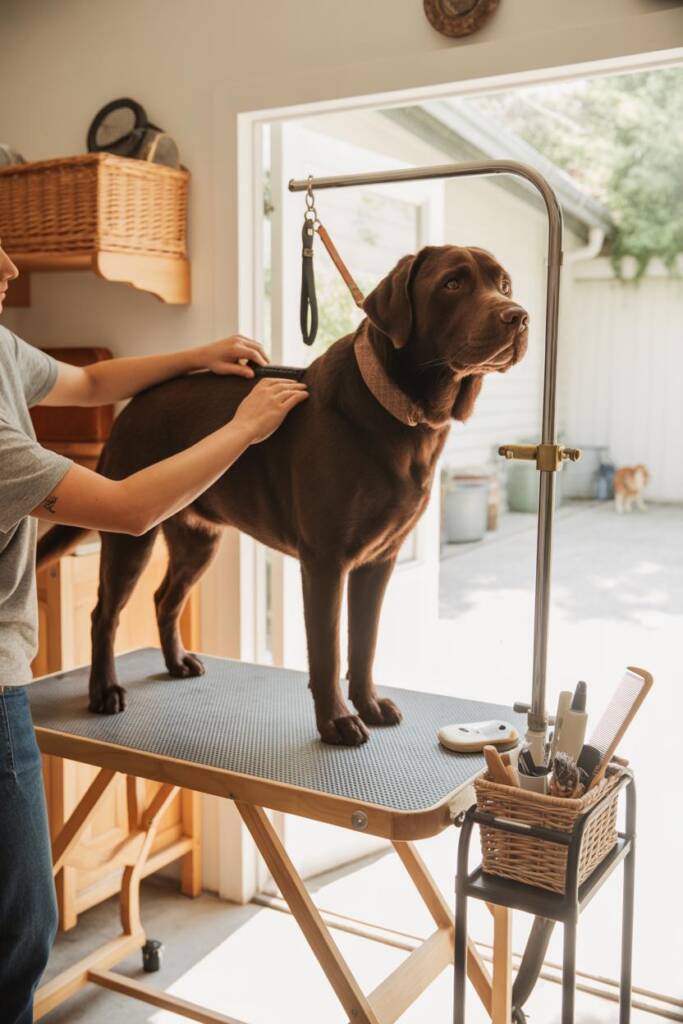
Bending over to groom a 70-pound Labrador is a back-killer. A simple elevated grooming station transforms the experience from painful to pleasant, and you can build one in less than an hour with basic materials from any hardware store.
Three Essential Components
You need a stable platform at waist height (roughly 36 inches for most people), a non-slip surface, and a grooming arm with leash attachment to keep your Lab in place. Use a sturdy folding table as your base, cover it with a rubber-backed bath mat for traction, and attach a grooming arm using a C-clamp secured to the table edge. The arm keeps your dog positioned correctly without you needing to hold them, freeing both hands for brushing.
The Setup That Takes 30 Minutes
Purchase a 3-foot folding table with a weight capacity of at least 200 pounds (even though your Lab weighs less, you want stability). Add a 24×36 inch rubber bath mat with suction grip on the bottom side. The grooming arm with adjustable height and rotating clamp costs around $25 online and clamps securely without damaging the table. Set this up in your garage, covered patio, or even your bathroom. The folding table stores flat when not in use, making this perfect for smaller homes. Total cost: under $75, and your chiropractor will thank you.
7. Humidity Control = Less Airborne Fur
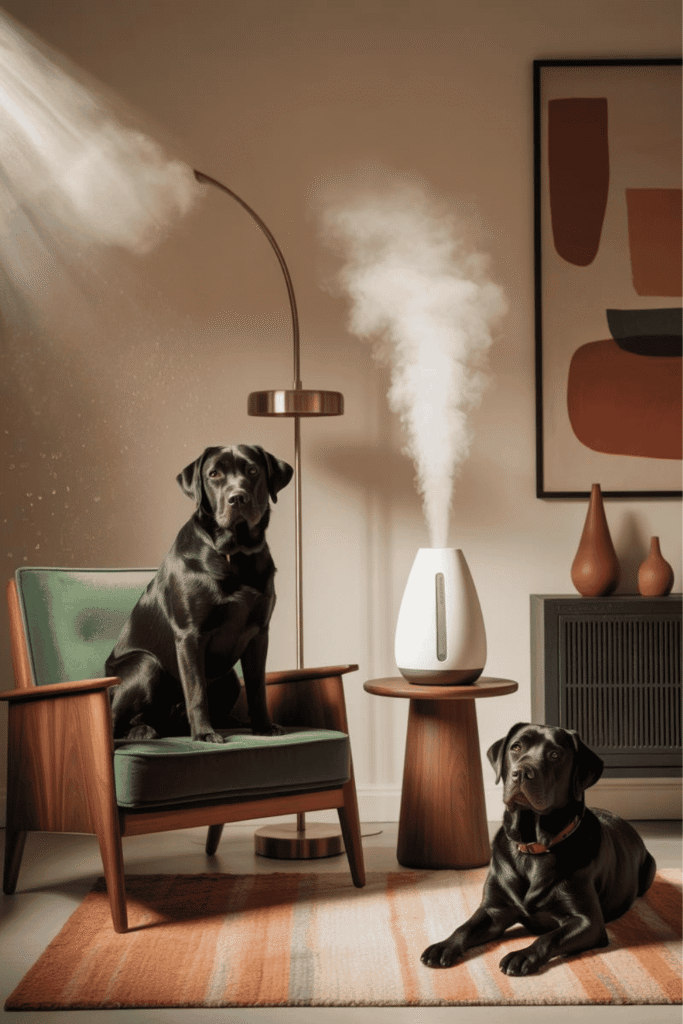
Here’s something most Lab owners never consider: dry indoor air makes shedding worse. When humidity drops below 30%, your dog’s skin dries out, causing more dead skin cells and brittle hair that breaks and sheds more easily.
The Surprising Connection Between Dry Air and Shedding
Low humidity doesn’t just make your dog shed more; it makes the shed fur become statically charged, which is why it clings to everything and floats through the air like furry confetti. Maintaining indoor humidity between 40-50% keeps your Lab’s skin moisturized and reduces static, meaning loose fur falls to the floor (where your robot vacuum catches it) instead of adhering to your clothes and walls.
Add a humidifier to the room where your dog spends most time, especially during winter when heating systems dry out indoor air. You’ll notice less fur flying around within days, plus your own skin will feel better too.
8. The Seasonal Shed Survival Kit
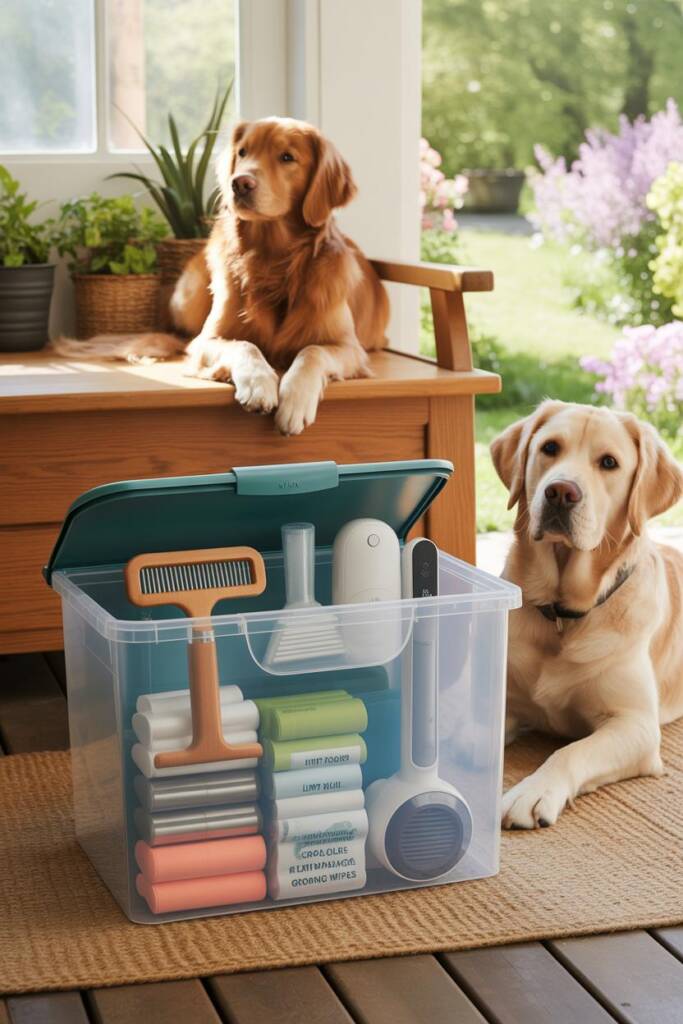
Labs “blow their coat” twice a year, typically in spring and fall. During these 3-4 week periods, shedding intensifies dramatically. Having a dedicated kit ready means you’re not scrambling when the fur storm hits.
Spring and Fall: Your Action Plan
Mark your calendar for late March and late September (adjust based on your climate). Two weeks before these periods begin, increase your grooming frequency to every other day. During the actual blow-out period, brush daily outdoors if possible. The seasonal shed has a beginning, middle, and end; the middle two weeks are the worst. Power through with daily maintenance, and you’ll get through it without your home looking like the inside of a fur coat.
What to Keep in Your Kit
Assemble a plastic storage bin with these essentials: undercoat rake, rubber grooming mitt, lint rollers (buy in bulk), a handheld vacuum for furniture spot-cleaning, and grooming wipes for quick touch-ups. Add a trash bag designated for fur and keep everything together in one accessible spot. When shedding season hits, you’ll grab your kit and go instead of hunting for scattered supplies. Bonus: keep a spare set of these items in your car for on-the-go fur emergencies.
9. Fabric Choices That Hide Hair Like Magic
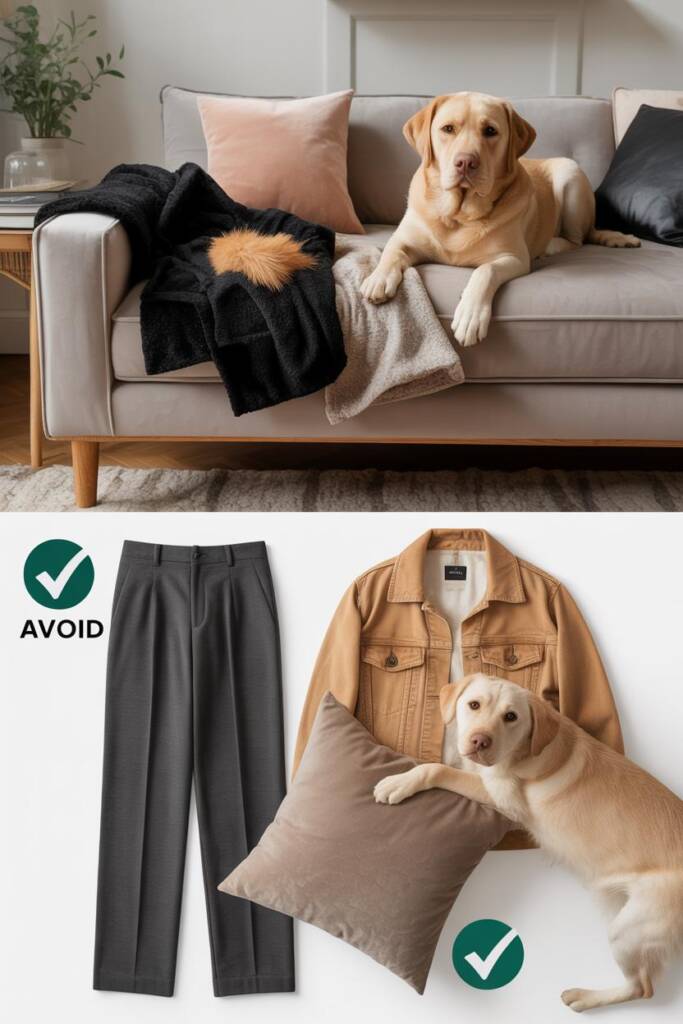
Some fabrics are fur magnets, while others practically repel it. Once you understand this, you can make strategic choices that dramatically reduce visible dog hair without changing your style.
The Worst and Best Fabrics for Lab Owners
Avoid fleece, velvet, corduroy, and anything with a textured weave. These fabrics grab and hold Lab hair like Velcro. Instead, choose tightly-woven cotton, microfiber, leather, or performance fabrics marketed as “pet-proof.” For clothing, stick with denim, canvas, and ponte knit fabrics.
Color matters too: choose medium tones that match your Lab’s fur color (tan, brown, or charcoal gray) rather than pure black or white. The hair is still there, but it’s camouflaged. For throw blankets and decorative pillows, silk and satin blends allow fur to brush off easily rather than embedding in the fibers.
10. The 5-Minute Car Hack Before Every Ride
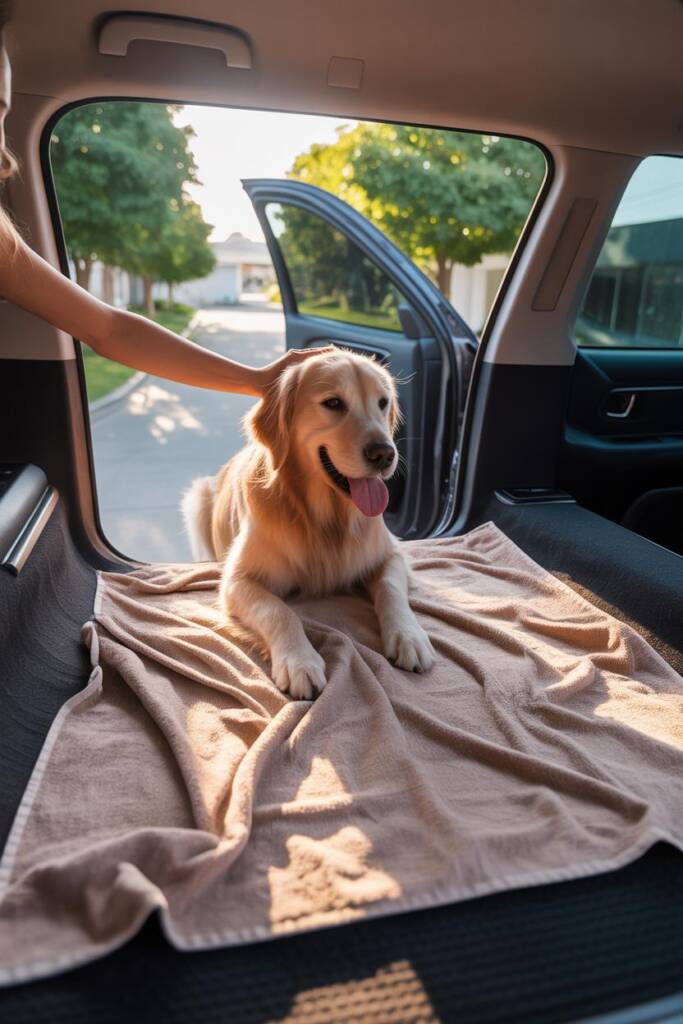
Your car interior doesn’t have to become a mobile fur factory. A simple pre-ride routine keeps 90% of shed hair contained and makes cleanup effortless.
The Towel Trick That Changes Everything
Before your Lab jumps in, lay a large damp (not wet) towel across the seat or cargo area where they’ll sit. The slight moisture causes loose fur to stick to the towel instead of embedding in your upholstery or becoming airborne. After the ride, take the towel outside and shake it out, then toss it in the wash.
This works because dry fur has static electricity that makes it cling to fabric, but the damp towel neutralizes that charge. For longer trips or heavy shedders, use a waterproof car seat cover with raised edges over the damp towel for double protection. The combination catches both the loose fur and any dirt or moisture your dog brings along.
Shopping List to Make These Hacks Work
Getting started with serious shedding control doesn’t require a massive investment. These five items will give you the foundation to implement most of the hacks above and make an immediate difference in your home.
- High-Velocity Dog Dryer – Unlike human hair dryers, these are designed to blast loose undercoat free before it sheds naturally. The concentrated airflow reaches deep into your Lab’s double coat, and using this before your weekly grooming session makes brushing three times more effective. Look for models with variable speed settings and cool air options.
- Undercoat Rake with Rotating Teeth – This is the single most important tool for Lab owners. The rotating pins prevent hair breakage and discomfort while pulling out massive amounts of dead undercoat that regular brushes miss. The difference between a standard slicker brush and a proper undercoat rake is like comparing a broom to a vacuum.
- Pet-Safe Omega-3 Supplement – Liquid fish oil designed specifically for dogs (not human supplements, which can have harmful additives) strengthens hair follicles from the inside out. Choose wild-caught fish sources and pump dispensers for easy meal mixing. Consistency matters more than brand name, so find one your Lab tolerates and stick with it.
- Washable Furniture Throw in Microfiber – A quality furniture cover pays for itself in saved cleaning time and preserved upholstery. Microfiber is virtually fur-proof thanks to its tight weave, and modern options come in dozens of colors that actually complement your décor. Choose machine-washable varieties that can handle hot water and frequent laundering.
- Robot Vacuum with Pet Hair Specs – This is the investment that keeps giving. A robot vacuum with strong suction (2000Pa+), rubber extractors, and scheduling capability runs consistently so fur never builds up into those tumbleweeds that migrate across your floors. Self-emptying models eliminate the daily dustbin maintenance that makes cheaper robots impractical for heavy shedders.
Making Shedding Management Part of Your Routine
The difference between Lab owners who feel overwhelmed by shedding and those who manage it successfully isn’t effort; it’s strategy. These ten hacks work because they’re proactive rather than reactive. You’re preventing fur from spreading through your home instead of constantly cleaning it up after the fact. Implement even half of these techniques, and you’ll notice a dramatic reduction in visible dog hair within two weeks.
At Sweet Purrfections, we’re all about practical solutions that make life with pets easier and your home more beautiful. Whether you’re a dog person, a cat person, or someone who just loves creating a comfortable space for the whole family, we’ve got the tips and tricks that actually work in real life.
Meet Sean, a fintech whiz with a penchant for pet purrs and blockchain buzz. After a decade of fintech feats, Sean’s tech talents leaped from ledger lines to litter lines, driven by a passion for pets and a vision for a more connected pet care community. With three critter companions as co-pilots, Sean launched this blog to share a treasury of pet-friendly tech tips and tales.



Leave a Reply